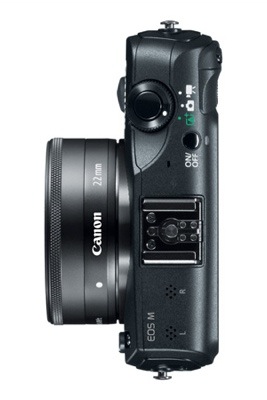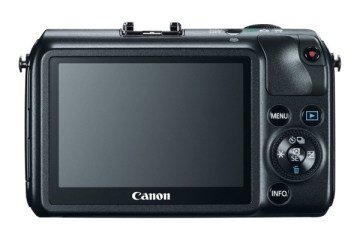At just under $800, Canon’s new EOS M isn’t really priced for the masses, but if you want to lay hands on the company’s first camera without a mirror, Canon says to look for it in October.
With the EOS M, we’re talking about something the industry often refers to as a “Compact Systems Camera,” or CSC (alternately “Mirrorless Interchangeable-Lens Compact,” or MILC). That means, in contrast to your average digital compact, it has an interchangeable lens mount and doesn’t employ a mirror-based optical viewfinder.
(MORE: UCLA Researchers Build World’s Fastest Camera to Screen for Cancer)
Introducing a mirror-less camera is big news, though only for Canon: It’s actually the last of the major camera manufacturers to offer a CSC model, as rivals like Panasonic and Nikon already do. The main advantage of a CSC is that it allows manufacturers to offer a crucial pro-shooter feature — the ability to attach alternative lenses — in a relatively small camera frame.

Canon
How small?It’s 4.28 inches wide by 2.62 inches high by 1.27 inches deep, and weighs 262 grams (just over half a pound) without a lens. Canon says it’s “approximately 59% thinner” and “50% lighter” than its EOS Rebel T4i (aka “EOS 650D” overseas). The company also says it uses roughly a third fewer buttons than comparable DSLRs.
Speaking of the EOS Rebel T4i, it looks like the EOS M employs the same sensor as the former mirror-based DSLR: an 18-megapixel APS-C CMOS, allowing for images up to 5,184 by 3,456 pixels, and notably better than the sensor in the comparably priced PowerShot G1x (the high end of Canon’s digital compact lineup that added hundreds of dollars to the G-series price tag).
Inside the EOS M, you’ll find a Digic 5 processor (“for exceptional image quality video and photos,” says Canon), also used in the EOS Rebel T4i, as well as the same hybrid autofocus system, supporting both phase and contrast detection (for determining the correct focus by passively analyzing an image).
The camera’s backside harbors a 3-inch touchscreen with about 1.04 million dots, and its native sensitivity rating for stills can be manually set between ISO 100 and 12,800 (ISO 100-6400 for video), though you can expand this up to ISO 25,600.
The EOS M doesn’t have an inbuilt flash, so you’ll need to buy another peripheral: Canon just announced the Speedlite 90EX ($150), designed for the EOS M, which supports 24mm wide-angle lenses.

Canon
Canon says it’s designed two lenses specifically for the EOS M: the EF-M 22mm f/2 STM (35mm equivalent, comes with the camera) and the EF-M 18-55mm f/3.5-5.6 IS STM ($300).
But the arguably more important news is that Canon’s made the EOS M compatible with its full line of EF and EF-S lenses if you pick up the Mount Adapter EF-EOS M ($200). By dropping the mirror, Canon was able to thin the camera frame, but at the expense of default lens compatibility, thus the optional mount.
Last (and arguably least), Canon’s added seven “creative filters” for post-processing in the EOS M, which seems a little silly and distracting given the presumed target audience, but if you really want to fiddle with effects clichés like “Fish Eye,” this camera’s got them.
Canon may be pushing it a little when it calls the EOS M “an ideal movie-making tool,” but then, hey, entire movies have been made on an iPhone 4, and that’s partly what Canon’s trying to draw into stark relief here: the upsides of owning a much higher-end, dedicated camera bristling with optical options, versus using smartphones with increasingly competitive (if rudimentary) specs.
Incidentally, if you’d prefer a white model to the standard black version, Canon says it’ll offer one exclusively through its online store.

